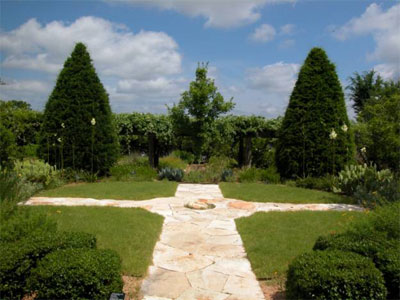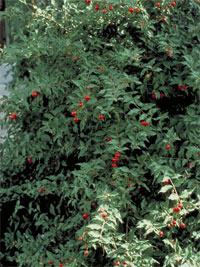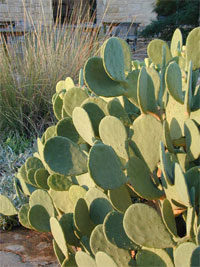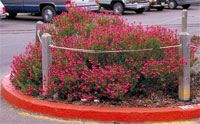Wild About Texas – November, 2008

Eastern redcedars, Juniperus virginiana, and dwarf yaupon hollies, Ilex vomitoria ‘Nana’ (in foreground). Photo by Andrea DeLong-Amaya.

Texas sage, Leucophyllum frutescens. Photo by Andy and Sally Wasowski.

Barbados Cherry, Malphighia glabra. Photo by Paul Cox.

Spineless prickly pear, Opuntia ellisiana. Photo by Joe Marcus.

Autumn sage, Salvia gregggii. Photo by Benny Simpson.
Hedges soften noise from adjacent properties, provide privacy, guide pedestrian traffic, demarcate boundaries, act as living fences to keep dogs and children inside a yard, and can even be groomed into hedge mazes!
What makes a good hedge? Typically we look for durable, carefree shrubs with dense evergreen foliage, often suitable for shaping. Sometimes hedges are sheared tidily, and plants must be suited to such relentless attention. Numerous native shrubs make fabulous natural-looking hedges, and it may seem inappropriate to trim them up. The plants listed below are malleable and take well to shearing, with the exception of spineless prickly pear, which is better shaped by selective pruning. Most listed are deer-resistant.
Yaupon holly, standard and dwarf (Ilex vomitoria) — Plants are either male or female, with females forming translucent red berries which are toxic to people (hence the species name vomitoria”). Dwarf yaupons stay much smaller than standards, and both take well to shearing, rivaling boxwoods. The fine texture of the small leaves makes yaupons ideal for hedging.
Ashe juniper (Juniperus ashei) — Although a common source of insidious allergens, junipers offer dark, even foliage, superb for garden backdrops and sound insulation.
Eastern redcedar (Juniperus virginiana) — See above information for ashe juniper. Eastern redcedars are more upright than ashe junipers, and some selections naturally take on a columnar form.
Cenizo, Texas sage (Leucophyllum frutescens) — A strong contrast to shadowy dark green plants, cenizo has a hoary glow. ‘Green Cloud’ is a variety with greener foliage that retains a hint of ashiness. Fast growth, extreme drought tolerance, and lavender summer blossoms are other strong features.
Agarita (Mahonia trifoliolata) — Agarita is a prickly option for just the right spot. Honey-scented flowers in early spring are followed by sweet, edible red berries. Most gardeners wouldn’t consider shearing this plant, but it does surprisingly well kept tight and is exceptionally xeric.
Barbados cherry, standard and weeping (Malphighia glabra) — Both types may be sheared, but the weeping shape of the latter will be lost. Attractive flowers and fruit appear from late spring through frost. Not reliably evergreen in the colder parts of the state.
Wax myrtle, standard and dwarf (Morella cerifera) — The dense, fragrant, dark green foliage makes a great hedge. Plants sucker occasionally, forming a thicket over time.
Spineless prickly pear (Opuntia ellisiana) — A non-traditional option for a barrier, prickly pears offer a sculptural quality to the landscape, with no supplemental irrigation required.
Autumn sage, cherry sage (Salvia greggii) — If you are looking for copious flowers on a small evergreen shrub, cherry sage is a strong candidate. The plants perform best when cut back in late winter or early spring to new growth, removing old, woody branches.
Skeleton-leaf goldeneye (Viguiera stenoloba) — Evergreen native of the western part of the state, this goldeneye is also very forgiving of dry conditions. Strongest flowering occurs in the fall, when shrubs are enveloped in saffron-colored daisies.
For more information about Texas native plants, visit the Wildflower Center’s website at: www.wildflower.org.
About the author: Andrea DeLong-Amaya is the director of horticulture at the Lady Bird Johnson Wildflower Center in Austin.
